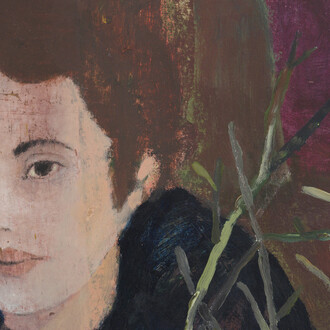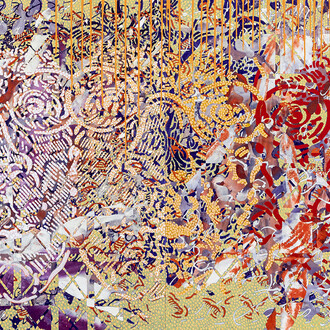In his book, The Flesh of Words, Jacques Rancière examines the intimate relation binding poetry with politics and defends the hypothesis that poetry, in its lyric or even subjective form, either voluntarily or unconsciously articulates political ideas, summarizing them into visual and metaphoric concepts and harmoniously integrating them into the collective imagination. His position is echoed in Karishma D’Souza’s work, as the artist in her artistic practice consciously intertwines these two dimensions in order to highlight their codependent natures. In fact, the poetry created by Karishma D’Souza has a lyrical, simple almost naïve form that is saturated with references to often violent political realities. However, Karishma D’Souza doesn’t harness poetry’s strength only to discuss politics – she also attempts to sublimate the subsequent forms of a given political context, in order to return to the universal origins and to resurrect the noble discourse of our ancestors that was almost nearly forgotten.
Karishma D’Souza is of Indian decent and was inspired by the environment where she grew up. The pastoral scenes in her paintings transport the visitor to the countryside or to the foot of the Himalayas, allowing him to contemplate the harmonious and peaceful landscapes. Nothing seems to upset the tranquility of the scenes – however, harmony is only an illusion.
The political situation in India to which Karishma D’Souza’s paintings make reference is anything but harmonious: the economic and industrial development has accentuated the gap between classes and has even exacerbated social stratification, which was configured and solidified over centuries by the polemic caste system. The artist considers this archaic organization of social behavior atavistic. Therefore one of her references is Ambedkar’s discourse entitled Annihilation of Caste. Since the 1930s, when the Project of Unseeing was first started, speaking of “castes” or “untouchables” was avoided in official discourse and, since 2004, nationalist propaganda has glorified the idea of an India Shining. It speaks of positive evolution, of increased wealth, of developing industries, without saying a word about the real and socially violent situation of castes that continue to dictate human interactions. Some of Karishma’s oldest works were produced in somber tones in order to contradict the forced brilliance of the slogan India Shining. The criticism of this phenomenon becomes subtler in her recent paintings where the soft and peaceful light (as if the light was coming from within) attempts to parody the very notion at the heart of the metaphor.
The political dimension is nevertheless not the only dimension depicted in Karishma D’Souza’s paintings. Certainly, the artist tries to show the contradictions inherent in this double-sided political discourse, but that is not her principle objective. She reveals the political aspect of contemporary reality so that she may sublimate it through her poetic transformation of the world. To arrive at this sublimation, the artist draws inspiration from Sufi poetry (part of Islamic worship) and occidental literary texts that also allow her to return to the heart of it, to the pure beginnings of things, and to the innocence of a gaze. In other words, to what is universal. This dimension becomes even more obvious if we consider the technique adopted by the artist. Her paintings are halfway between a mystical and poetic vision – and all the while they translate archetypal elements into contemporary visual metaphors. Inspired by Rajasthani miniatures, made with very fine brushes, the artist reinterprets them by enlarging the paintings without loosing the link to the original technique that is as meticulous as it is detailed. Coming from the iconographic practice of icons, which only allows for the representation
of God in the two-dimensional form and imposes a coded and classified use of colors, Karishma D’Souza constructs her own connoted and paradoxical vocabulary that is always polarized by her political and poetical visions. The first reading recalls the violent realities whereas the second opposes them, trying to reach an ultimate sublimation and reconciliation. Thus the gold color references both the idea of vanity and that of interior richness. The blue references rebellious political unrest and peace. The artist attempts to also touch the divine, which is, if we translate it into metaphysical terms, the source of everything, the ultimate origin. The light of her paintings should not be understood only as the appearance of paradise, parodied through the reference of India Shining. It also embodies the true harmony, a sought-after tranquility that is finally found. The lit spaces – bright, practically deprived of shadow – function as imaginary reservoirs where the essence of things can be seen because they have finally become visible: the truth of forms as well as the true forms can only be unveiled in the brilliant light of revelation. This mystical experienced comes from the contemplation of icons, which the artist tries to reproduce by creating new contemporary icons.
The idea of regained paradise is even clearer when we consider the literary inspirations that guide Karishma in her artistic practice. There are multiple links to Kabir texts (XVth-century mystic poet) next to biblical references (Ezekiel), poetry (Emily Dickinson, Robert Frost, T.S. Eliot) or philosophy (for example, Spinoza). These authors who lived in different times and contexts are all searching for God. In more secular terms, they are in search of the ultimate harmony as well as a personal and unique paradise: for Kabir, it takes the shape of Premnagar, the city of Love; for T.S. Eliot, it’s summed up in a metaphor, that of a rose garden which returns obsessively in his writings; for Emily Dickinson, it’s being in union with God; and for Spinoza, it’s Love. Regardless of these differences – time, space, or place – men’s dearest aspirations are the same in content even if the form changes. The exhibition title comes from this very idea: ancestors are the source of everything; they’re the origins, multiple but unified. We share them as we share a collective memory since our memory is woven from visions, symbols, and universal metaphors. For Karishma D’Souza, ancestral heritage is the nature that surrounds us and binds us to our origins. Ancestors are “democratic” as their knowledge isn’t predefined by class, castes, or education. Like the past that shapes us, they belong to everyone.
One of last books Karishma D’Souza read was The Conference of The Birds – Mantiq Ut-Tair written by the XIIth-century Sufi poet Farid-ud-din-Attar and it illustrates this idea. Thirty pilgrim birds set out to look for God in the Seven Valleys – the Valleys of Quest, Love, Knowledge, Separation, Unity with God, Stupefaction, Poverty, and Devastation – only to find God in themselves. Since there is no duality, there is no distance between the divine and the living. For Karishma d’Souza the divine is in us: paradise, harmony, universality are in us. We must only search for the introspective path that was traced by our “ancestors” – “And I retrace old paths as if I discover forgotten verses. "
















